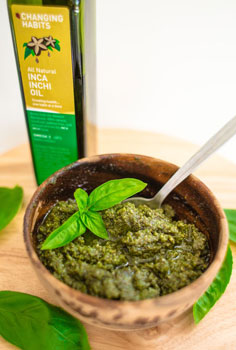Cyndi O'Meara Inca Inchi Oil Interview

Cyndi O'Meara Inca Inchi Oil Interview
You may not have heard of it yet, but Inca Inchi is the new big thing in health. Native to the Amazon, the nut is incredibly rich in protein, essential and non-essential amino acids, omega fatty acids plus vitamins and minerals.
Women of the Incan tribes have relied on the nut for many thousands of years for its unique health benefits. From beauty products to natural protein powder, Inca Inchi is a valuable resource.
Changing Habits source the nut directly from the farmers in Peru and have created Inca Inchi Oil and Inca Inchi Powder for Australian consumers. The oil is the single richest vegetable source of essential fatty acids which are imperative to good health. It is so rich in Omega 3 that it's comparable to fish oil and is also rich in amino acids, antioxidants and is easily digested, helping every cell work to its potential.
Since our bodies do not produce Omega 3, this is something we need to gain from our diet. There are a great number of health benefits to supplementing your diet with the oil:
Improved circulation and blood pressure
Reduced inflammation throughout the body (joints, blood vessels and elsewhere)
Reduces cholesterol
Improved joint pain
Lots more...
Try Inca Inchi Oil in salads, smoothies or simply take a spoonful each day for good health. The oil can also be used externally for sensitive, dry skin and even to nourish dry hair.
Changing Habits Nutritionist Cyndi O'Meara says: 'The fish oil industry has grown so significantly that it's now unsustainable. In my search for a healthy and ethical alternative I made up a spread sheet of all the plant based oils that I knew were available. I worked out their omega 3, omega 6's, their monounsaturated, polyunsaturated, saturated, essential oils etc. I felt there could not be one oil that could take the place of fish oil, so I decided to mix several together but ran into problems with emulsifying. It was only when I read up on the nutritional profile of Inca Inchi I was stunned to find that I had finally found an oil that fitted the profile of 48% omega 3 and 84% essential fatty acids. Bingo! My husband Howard and myself travelled to South America to ensure the quality of the nut and have since been distributing to Australia." 
Interview with Cyndi O'Meara
Question: What is Inca Inchi Oil?
Cyndi O'Meara: Inca Inchi Oil is extracted from the Peruvian native Inca Inchi Seed. It is a mild tasting cold pressed oil that has won many awards in the chef communities of America, Europe and South America. Because it has a mild taste and light colour it doesn't overpower pesto, mayonnaise, salad dressings and other cold produced condiments needing a mild oil. Instead of the oil being a dominant taste, the herbs, nuts, and other flavours added become the flavours of these condiments. Many beautiful cold pressed oils such as olive, avocado, coconut and macadamia, can overpower the taste of foods and so with the introduction of Inca Inchi oil into the Australian market chefs and home cooks can now use a healthy oil for these beautiful foods as opposed to using canola, rice bran and grape seed oil which are highly refined, low in nutrition and in the case of canola may be genetically modified.
Question: Can you tell us more about the Inca Inchi nut?
Cyndi O'Meara: The Inca Inchi plant is grown in South America. It is small plant with hermaphrodite flowers producing small pods (green at first and brown when ripe) with 6 lobes. Each lobe contains a seed with a width of around15 to 20 mm and an average weight of 1gm. Inca inchi seeds are rich in nutrients and essential fatty acids. The plant is cultivated mainly in the district of Pichanaqui (Junín - Peru) in the heart of the Inca culture; the land offers the best environmental conditions for the plant to grow (soft ground with a high content of minerals and nutrients).
The Inca Inchi plants are grown at 500m above sea level - near where the Andes and the Amazonian jungle meet. It is protected from excessive rain, flooding and strong winds. Inca Inchi is a native wild plant of South America but today it now cultivated in and around the Amazon. The growing of Inca Inchi plant contributes to the economy and health of the local people.
The Inca Inchi seed is harvested and used whole or can be processed into a cold pressed oil and cake. The cake is high in protein and is now being sold as Inca Inchi Protein powder a non-concentrated, non-isolated, nothing-added-to pure food that contains 64% protein along with other essential nutrients for the assimilation of protein. It is a far superior protein powder then other protein powders available on the market today.
Question: What makes Inca Inchi Oil the newest superfood?
Cyndi O'Meara: Inca Inchi Oil is extracted by cold pressing the Inca Inchi seed.
It is considered the single richest vegetable source of essential fatty acids containing 86% essential fats including linoleic Omega 6 and alpha-linolenic Omega 3. The human body does not manufacture these fatty acids on its own; therefore it's imperative we consume them for good health. By consuming these two essential fats the body is then able to make EPA, DHA, GLA, and many more fats required for health. The inca inchi oil is 48% Omega 3 an important anti-inflammatory fat that is also the precursor for EPA and DHA (fats found in fish oil but also made by the body) Inca inchi oil is also high in anti-oxidants, including Vitamin A and all eight factors of Vitamin E. The oil can be eaten as well as used on the skin and hair. The structure of this oil aids in protecting the skin, hair and nails by limiting dehydration while it strengthens and builds up natural defences to common external and dietary exposures. Inca Inchi oil is an excellent ingredient to use in products designed to combat inflammation, irritation, dryness and skin damage.
Question: Why do our bodies need Omega 3 and fatty acids?
Cyndi O'Meara: There are only two types of fats that are essential for us to consume for good health. They are alpha-linolenic (Omega 3) and linoleic (Omega 6). Omega 3 is necessary because they are the precursors to many other fats that the body requires.
From Omega 3 and Omega 6 the body can manufacture all other fats. In order to do this the body must have other nutrients (vitamins and minerals) to perform the biochemical reactions. These are provided by other foods as well as gut bacteria (B Vitamins and Vitamin K2).
These fats have many roles in the body including, cell structure, manufacturing of components that the body requires for communication, storage and transport. They are also important in brain function as well as playing a key role in decreasing inflammatory process and thereby cutting the chance of disease. Along with a healthy diet these fats contribute to a body that functions well and is totally healthy. They have many key roles but they require other nutrients for them to perform to their best ability.
Question: How does Inca Inchi Oil compare to Coconut Oil/Butter?
Cyndi O'Meara: Inca Inchi has very little saturated fat, it is mainly unsaturated and is not an oil that should be heated. It should be kept in a dark bottle and a cool place so that it does not oxidise. When you heat this beautiful oil you destroy the fat soluble vitamins as well as oxidise the Omegas which in turn cause inflammatory processes and free radicals to form, this causes accelerated ageing.
Coconut oil on the other hand is 98% saturated fat, it is a stable fat in heat and light and does not oxidise when heated or exposed to light. Therefore I only use coconut oil, lard, butter or any other saturated fat when I cook. Coconut oil has short and medium-chain fats, which means the body sends this fat to the liver and it is converted into energy rather than stored in the fat tissues. Most fat that is stored in the fat tissues is fat that is produced by the body as a result of excessive carbohydrate consumption.
Both Inca Inchi Oil and Coconut Oil are in my cupboard but are used for very different purposes in my cooking.
Question: How much of his product do we need, daily?
Cyndi O'Meara: Everyone seems to be obsessed about how much we need every day of this product. When you eat a diet rich in fruit, vegetables, meat, fish, chicken, nuts, seeds, eggs, and quality dairy, then Inca Inchi oil is a part of the diet that contributes to your omega 3's and essential fats. I make sure I have inca inchi most days, but I don't take it in pill form but rather as part of my eating regime. I may have some pesto (made with inca inchi) for breakfast with my eggs, or I might have some salad dressing on my salad at lunch or dinner in which inca inchi is part of the ingredients of the salad dressing or mayonnaise. But if you want structure then approximately 1 TBS a day.
 Question: How would you use the Inca Inchi Oil in your kitchen?
Question: How would you use the Inca Inchi Oil in your kitchen? Cyndi O'Meara: I never heat Inca Inchi oil, therefore it is only used in cold or warm dishes, such as pesto, salad dressing, mayoinnaise, already cooked pasta or rice dishes, added to a cooled risotto or dipped with dukka.
Question: How can Inca Inchi Oil be used as a beauty product?
Cyndi O'Meara: Inca Inchi oil can be used on the skin and I often mix it with some beautiful essential oils such as neroli, bergamot and sandalwood. The structure of this oil aids in protecting the skin, hair and nails by limiting dehydration while it strengthens and builds up natural defences to common external and dietary exposures. Inca Inchi oil is an excellent ingredient to use in products designed to combat inflammation, irritation, dryness and skin damage.
Question: Can Inca Inchi Oil replace our fish oil supplements?
Cyndi O'Meara: I believe the fish oil industry is unsustainable and unethical. It takes 5kg of fish to produce just 1kg of fish oil and with dwindling fish in our oceans and the fact that much of our fish oil is extracted from farmed fish; the oil is not the best quality. Because fish oil is expensive, in order for profits to be high, other oils are added and the oil is put into gel caps that may have dubious ingredients. Flavours, artificial sweeteners and colours are added to disguise the taste of the fish oil. The reason we eat fish oil is for the EPA and DHA, it has been touted as being anti-inflammatory, but with all the processing and additives I wonder if they don't counteract each other.
Inca Inchi oil with weekly consumption of fish (calamari, salmon, prawns etc) has the ability to give us all the Omega 3, EPA and DHA the body requires. Even without eating fish but having a diet rich in real foods the body will make the EPA and DHA it requires for health.
I find it absolute madness and ludicricy to eat a junk food diet filled with inflammatory foods and then consume fish oil to dampen the inflammation.
Interview by Brooke Hunter
MORE



